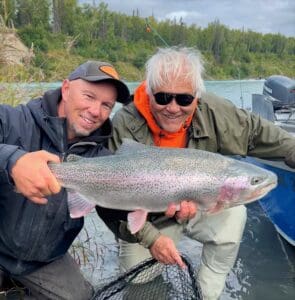When Kenai River trout are on the bite is seems like you can do no wrong. An angler can make lots of small mistakes in their approach and presentation, yet still catch lots and lots of fish throughout the day. While these days are certainly a ton of fun, they can also lead to the development of some bad habits that will have negative consequences on the days that our Kenai River trout are being a little more snobby. Below are 3 common mistakes that I see made over and over again by anglers fishing for Kenai River Trout:
1. Not Enough Weight
The most common method to target Kenai River trout is with either a bead or an egg fly, both of which imitate salmon parts that make up the majority of the diet of Kenai River trout through the summer and fall months. Often there is so much trout food in the system that trout don’t have to move much at all in order to feast, and so they very rarely will come up off the bottom to feed. This is why you must keep your offerings on the bottom the majority of the time in order to be successful catching Kenai River trout. Many times I hear anglers say “all the fish were in the shallows today,” because that’s where they caught most of the Kenai River trout. But the likely reason for this is that they didn’t have sufficient weight, and so the shallow areas were the only part of the drift in which their bead or flesh fly was actually on the bottom and in the strike zone.
2. Casting Way Too Much
One of my biggest pet-peeves when fishing for Kenai River trout is when the angler re-casts their line too much. So often the indicator is just getting into a great spot where a bite is likely to happen, only to have the angler pick up the line to cast again. It’s so frustrating, especially when it gets cast right back to the exact same line! What is the point? When fishing for Kenai River trout we are able to drift along with the line, facilitating long drifts that can be highly productive. While it’s important to occasionally check your rig to make sure everything is in order, you can typically float a hundred yards or more without removing your line from the water, effectively covering a lot of water while staying right in the strike zone.
3. Over-Mending
While fly fishing for Kenai River trout it’s important to try and get a natural drift. Both eggs and flesh are going to be drifting down the river at the same speed as the current, and so if your offering is drifting significantly faster or slower than that, you’ll see a marked decrease in the number of strikes you get. Most anglers know this, and so an occasional mend of your line is important. But far too many Kenai River trout fishermen mend way too often and way too far. It’s common for anglers to mend their line well past the indicator, even flipping the indicator itself upstream in the process. When this happens, it throws the dynamics of the drift off, allowing a Kenai River trout to bite without being detected for quite some time. By the time the fish bites, moves far enough for the indicator to sink, and the angler to react it’s usually way too late and you either miss the bite or never even know it happened.


0 Comments